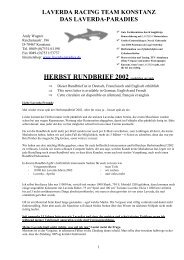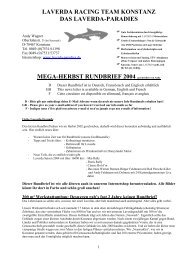68 Wichtige Tips Einstelldaten und ... - Laverda-Paradies
68 Wichtige Tips Einstelldaten und ... - Laverda-Paradies
68 Wichtige Tips Einstelldaten und ... - Laverda-Paradies
Create successful ePaper yourself
Turn your PDF publications into a flip-book with our unique Google optimized e-Paper software.
TIPPS FÜR VERGASERPROBLEME<br />
CONSEILS POUR PROBLÈMES DE CARBURATEURS<br />
TIPS FOR CARBURETTOR PROBLEMS<br />
1000/1200-180°+120°<br />
Kapitel<br />
Chapitre<br />
Chapter<strong>68</strong><br />
justments the problem is no nearer being solved, then either you have adjusted the wrong carb part or the carburettor itself is not<br />
the problem, instead something like bad wiring which is causing misfiring <strong>und</strong>er heavy vibration at certain engine speeds.<br />
�Even if you are convinced that the carb is the problem and you are not getting anywhere, try to focus more on the electrical system.<br />
Try wiring up additional earth connections to the ignition, engine, frame, etc.<br />
�If the bike is not running correctly in a certain rev range, do not make the common error of increasing or decreasing the size of the<br />
main jet. The main jet only comes into play when the twistgrip and throttle slide are almost fully open.<br />
�Always be careful when you are testing out different things. Riding too long with too lean a mixture can hole a piston.<br />
�Have you checked the engine compression? Things like this are also important.<br />
�Heavy oil consumption reduces performance.<br />
�On the carburettor, you can only<br />
- adjust the carb float level (not to be ignored)<br />
- idle mixture adjuster screw<br />
- idle adjuster screw<br />
- synchronise throttle slides<br />
This is not difficult. As a rule incorrect adjustment will not lead to engine or piston failure.<br />
�Real problems are usually caused by faults in the carburettor or by improper jetting.<br />
�Adjusting carburettors is very complex. Wear on carbs often means that you have to suddenly replace jets which have functioned<br />
perfectly well for years.<br />
�Jet sizes: 135 means that the jet aperture has a diameter of 1.35 mm. Always remember that someone may have tried to ream it out.<br />
Do not rely on the numbers on the jet being accurate, instead measure the aperture with a jet gauge.<br />
�If you are not sure whether your motorcycle is running too rich or too lean / if it does not run smoothly at a certain throttle opening,<br />
then pull the choke all the way. If the problem becomes worse, you can assume that the carb is running too rich already. If the problem<br />
disappears, then it is too lean. If nothing changes, you should check whether the choke pistons shut correctly.<br />
�If you have any symptoms that point to the mixture being too rich, you should first check whether the choke pistons shut correctly<br />
or if the sealing rubber in the piston and the spring are in good condition. Many carburettor problems are caused by this alone.<br />
�Always close the fuel taps when you park the motorcycle. If the bike has not been used for more than two weeks, take the time to<br />
let the petrol out of the carbs. Pull the petrol lines from the taps as well if you are not absolutely sure that the taps are not leaking<br />
when they are closed. To empty the carburettor, you can also let the motorcycle run with closed fuel taps until the engine dies.<br />
Not every bike lets you get as close to the carbs as a LAVERDA...<br />
�Leaky petrol taps are often the culprit when motorcycles refuse to fire up in the spring after sitting idle all winter. Petrol also evaporates<br />
quite quickly in the carb when it is cold. When this happens the float needle opens and a leaky fuel tap gradually releases petrol<br />
out of the tank drop by drop, which in turn evaporates. Dirt particles remain which interfere with the carb working properly or<br />
may even keep it from working at all. It is certainly easier to pull off the petrol lines than to thoroughly clean out the carburettor in the<br />
spring.<br />
�Unfortunately, it is also a fact that today's unleaded petrol is much more aggressive than leaded petrol used to be. This is not just<br />
something you read about in classic bike magazines, it is also my personal experience, because I have problems now which I did<br />
not use to have with my collection of 20 LAVERDAs ranging in c.c. from 49 through 75, 100, 200, 250, 350, 600, 750, 1000 to<br />
1200.Unleaded petrol really attacks the interior of tanks even if they are in use all the time. That is why I advise you to have your tank<br />
sealed before it is too late. The cost of buying a good used tank is much higher than investing in a tank-sealing gel set and a day's<br />
worth of work.<br />
�It is also cheaper to replace carburettor parts such as needles, jets, choke pistons, slides, than to risk holing a piston. Carburettors<br />
are subject to wear and tear as well and every once in a while you have to fit a new one.<br />
! Ignition problems first:<br />
If an engine has petrol and a healthy ignition spark, it will run. If there is no spark on any of the cylinders, consider silly things like a faulty<br />
kill switch, or the ignition unit getting no voltage, or a blown fuse, or corrosion on some minor contact area.<br />
Only a small, straight blue ignition spark between the centre and side electrode is a good spark. If the spark is ro<strong>und</strong>, very bright - almost<br />
white, moving back and forth - or if it comes out from between the insulator and the electrode, then the spark is bad and the plug<br />
needs replacing. This can happen with new spark plugs too - replace !<br />
If a bike starts up right away when you bump start it, but badly or not at all using the electric start, then you may have a problem with<br />
the battery, or poor magnetism on the magnet rotor , e.g. on the high-voltage condenser ignition of the 1000 LAVERDAs or 3 ½ Morinis.<br />
A further test is to use an external battery, e.g. from a car. Connect jumper cables directly to the electric starter motor and to the frame,<br />
so that the electric start gets its power supply from the car battery. Switch the motorcycle ignition and the kill switch to "on", press<br />
the electric start button and check to see if the motorcycle fires up better. If so, then you can be fairly certain that the motorcycle battery<br />
has insufficient power to feed the ignition system when you press the electric start.<br />
If you have unsuccessfully tried to start up the engine please make sure that it has not flooded. Always make sure that the spark on<br />
each plug is so<strong>und</strong><br />
Symptoms: A cylinder does not seem to be running properly, but which one ? ...with resultant low performance.<br />
Possible Problems: Faulty spark plugs, spark plug cap or HT lead, a fault in the ignition coil or other parts of the ignition system, or a<br />
defective carburettor.<br />
Help: To find out which cylinder is not working properly or not at all: start the engine up from cold and immediately check to see which<br />
exhaust downpipe heats up and which one stays cool or warms up much more slowly (careful: do not burn yourself). After discovering<br />
the cylinder which is not functioning correctly your next step is to find out why.<br />
Systematically interchange individual components such as spark plugs and ignition coils. If you have several ignition units, do the same<br />
here as well.<br />
Important: Always interchange components one at a time, never several sets of components at the same time, as this will give you no<br />
indication as to which part is faulty.<br />
If after you have changed a certain part another cylinder suddenly fails, then you know that this is the part causing trouble. This means<br />
that you should also make an effort to swap the carburettors aro<strong>und</strong>, as here again it is quite possible that one of them may be<br />
faulty.<br />
©LAVERDA Racingteam Konstanz · Andy Wagner · Phone 0 75 31 / 6 11 98 · Ersatzteilbestellungen während unserer Telefonzeit: Montag bis Donnerstag 15.00 -18.00 Uhr 349




